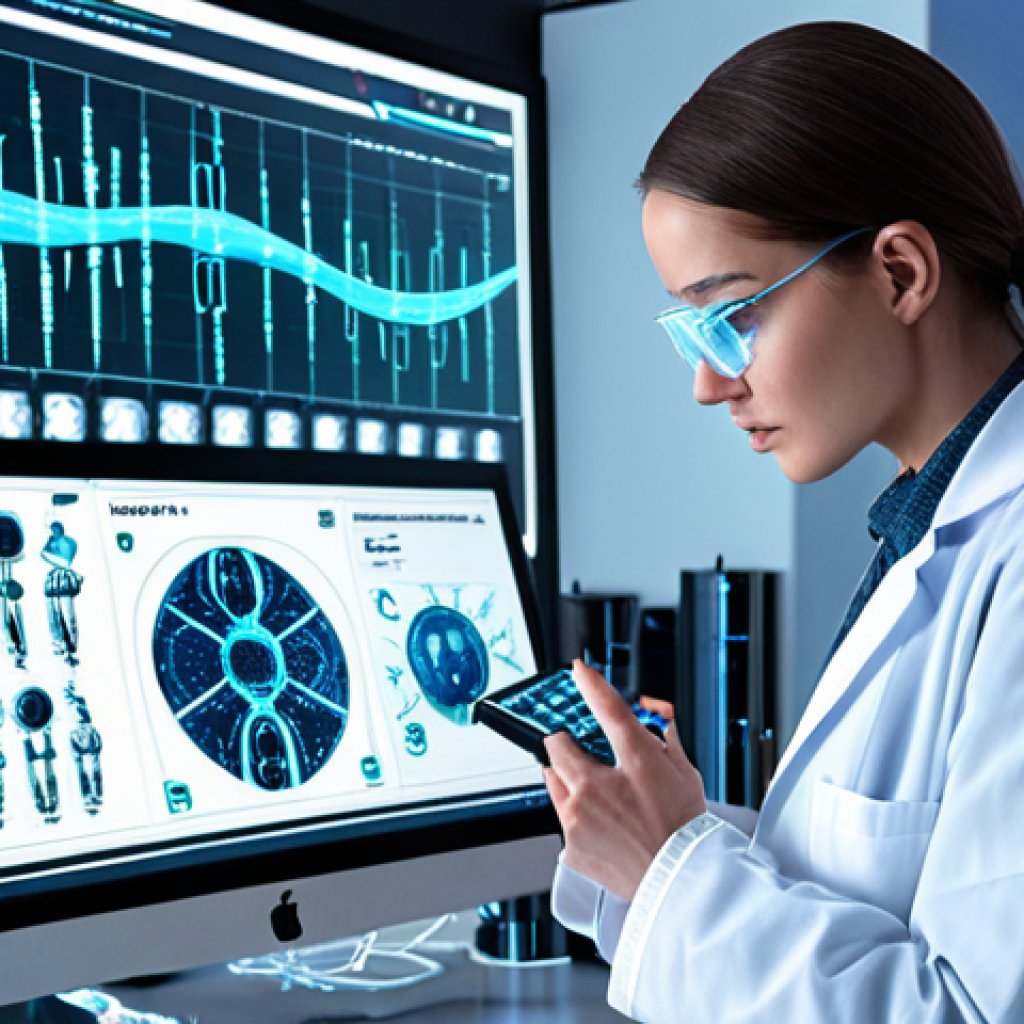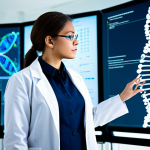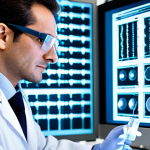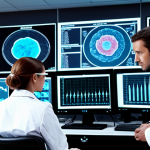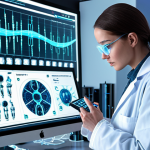Imagine a world where we can build DNA sequences like LEGO bricks, crafting custom genes and even entire genomes! That’s the promise of DNA synthesis technology, a revolutionary field that’s rapidly evolving.
I remember when synthesized genes were expensive and difficult to obtain, now they are becoming more readily accessible. The future is coming fast, with AI algorithms predicting optimal sequences for gene therapy and personalized medicine leading the charge.
This tech isn’t just about research, it’s poised to transform industries from pharmaceuticals to agriculture, and even materials science. The possibilities seem endless.
Let’s take a deep dive into the core details in the following writing!
Unlocking the Potential of Custom DNA: Applications Beyond Imagination
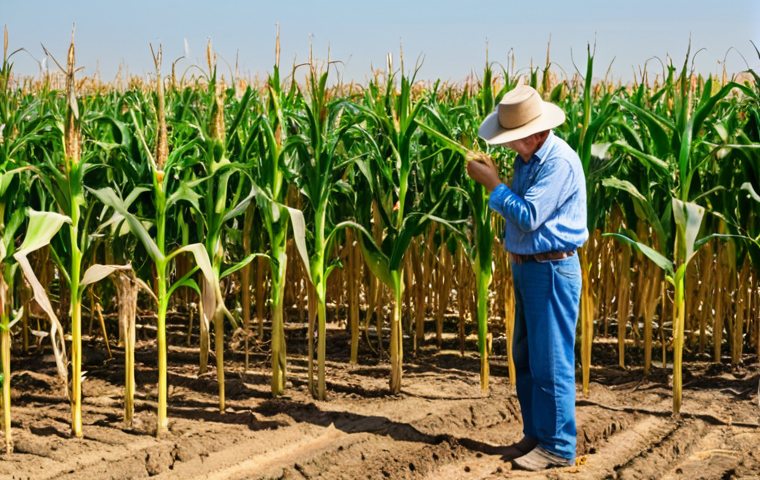
Targeted Therapies: Gene Editing’s Precision Strike
Gene editing technologies like CRISPR are revolutionizing medicine by offering precise ways to correct genetic defects. I remember reading about early gene therapy trials with a mix of hope and skepticism.
Now, seeing the progress, I’m convinced that personalized medicine will be the norm in the future. Think about it: instead of treating symptoms, doctors could target the root cause of diseases at the DNA level.
Companies are racing to develop gene-editing tools that can treat everything from cystic fibrosis to Huntington’s disease. The challenge lies in delivering these therapies effectively and safely to the right cells within the body.
It’s like programming a tiny robot to go in and fix a specific error, which is an analogy that makes me appreciate the complexity involved.
Sustainable Agriculture: Engineering Crops for a Changing World
DNA synthesis allows us to engineer crops that are more resilient to climate change, resistant to pests, and nutrient-rich. I once visited a farm where they were using genetically modified seeds to grow drought-resistant corn.
I was astonished by the yield compared to traditional methods. We’re talking about engineering crops that can thrive in harsh conditions, reducing the need for pesticides and fertilizers.
For example, we can introduce genes that allow plants to fix nitrogen from the air, reducing the dependence on synthetic fertilizers, which are a major source of pollution.
The possibilities extend to engineering crops with enhanced nutritional profiles, addressing malnutrition in developing countries.
Synthetic Biology: Building New Biological Systems from Scratch
Creating Novel Materials: Nature-Inspired Innovation
Synthetic biology is not just about modifying existing organisms but also about building entirely new biological systems. I once saw a presentation on creating synthetic spider silk, stronger than steel, using engineered bacteria.
It blew my mind. Imagine using synthetic biology to create self-healing materials, biodegradable plastics, or even living sensors that can detect pollutants.
Researchers are exploring ways to create materials with unique properties by mimicking nature’s designs. The key is to understand the underlying biological mechanisms and then use DNA synthesis to create the necessary components.
Biomanufacturing: Cells as Miniature Factories
DNA synthesis enables the programming of cells to produce valuable compounds, from pharmaceuticals to biofuels. I read a research paper recently about engineering yeast to produce artemisinin, a drug used to treat malaria.
It used to be extracted from a plant, but now it can be produced more efficiently and sustainably in a lab. We’re talking about using cells as miniature factories, programmed to produce the molecules we need.
This approach has the potential to revolutionize industries like pharmaceuticals, chemicals, and energy. The challenge lies in optimizing these biomanufacturing processes to make them economically viable.
The Ethical Landscape of DNA Synthesis: Navigating Uncharted Territory
Balancing Innovation and Responsibility: Safeguarding Against Misuse
As DNA synthesis becomes more accessible, it’s crucial to address the ethical implications. I worry about the potential for misuse, such as creating harmful pathogens or engineering organisms with unintended consequences.
There’s a need for robust regulations and ethical guidelines to ensure that this technology is used responsibly. Scientists, policymakers, and the public need to engage in open discussions about the potential risks and benefits of DNA synthesis.
The goal is to foster innovation while safeguarding against misuse.
Data Security and Privacy: Protecting Genetic Information
The increasing use of DNA synthesis raises concerns about data security and privacy. I think about the vast amounts of genetic information being generated and stored, and the potential for breaches or misuse.
Strong data protection measures are essential to prevent unauthorized access to sensitive genetic information. This includes implementing robust cybersecurity protocols, anonymizing data, and establishing clear guidelines for data sharing.
It is essential to build public trust by ensuring that genetic information is handled responsibly and ethically.
Democratizing DNA Synthesis: Accessibility and Innovation for All
Lowering Barriers to Entry: Empowering Citizen Scientists
The cost of DNA synthesis is decreasing, making it more accessible to researchers, entrepreneurs, and even citizen scientists. I follow several online communities where hobbyists are experimenting with synthetic biology in their garages.
This democratization of DNA synthesis has the potential to accelerate innovation and lead to new discoveries. Imagine a world where anyone can design and build their own biological systems.
The challenge lies in ensuring that these citizen scientists have the knowledge and resources to conduct their experiments safely and responsibly.
Fostering Collaboration and Open-Source Innovation: Sharing Knowledge for the Greater Good
Open-source platforms and collaborative projects are playing a key role in democratizing DNA synthesis. I’ve seen researchers sharing their designs and protocols online, allowing others to build upon their work.
This fosters collaboration and accelerates the pace of innovation. The goal is to create a community where knowledge is shared freely and openly, benefiting everyone.
Open-source DNA synthesis tools and resources can empower researchers and citizen scientists around the world to explore the possibilities of synthetic biology.
| Application | Description | Potential Impact |
|---|---|---|
| Personalized Medicine | Synthesizing DNA sequences tailored to individual patients for gene therapy. | Targeted treatments, reduced side effects, improved outcomes. |
| Sustainable Agriculture | Engineering crops with enhanced traits like drought resistance and higher yields. | Increased food security, reduced environmental impact. |
| Biomanufacturing | Programming cells to produce valuable compounds like pharmaceuticals and biofuels. | Sustainable production, reduced costs, new materials. |
| Materials Science | Creating novel materials with unique properties using synthetic biology. | Self-healing materials, biodegradable plastics, advanced sensors. |
The Future of DNA Synthesis: A World Transformed by Custom Biology
AI-Driven Design: Optimizing DNA Sequences for Specific Functions
Artificial intelligence is poised to play a major role in the future of DNA synthesis. I’ve been following the development of AI algorithms that can predict optimal DNA sequences for specific functions.
Imagine using AI to design genes that are more efficient, more stable, or more resistant to degradation. This could revolutionize fields like gene therapy, biomanufacturing, and materials science.
The key is to train these AI algorithms on large datasets of DNA sequences and their corresponding functions.
Beyond DNA: Exploring New Genetic Codes
DNA is not the only genetic code. Researchers are exploring the possibility of creating synthetic organisms with alternative genetic codes. I read about scientists who have created bacteria with an expanded genetic alphabet, using synthetic base pairs in addition to the standard A, T, C, and G.
This opens up new possibilities for creating organisms with novel functions. Imagine designing proteins with entirely new properties, or creating organisms that are resistant to viruses.
The potential is enormous, but so are the ethical considerations. This is one of the reasons I emphasize responsible innovation!
Navigating the Challenges: Scaling Up and Ensuring Safety
Addressing Technical Bottlenecks: Streamlining the Synthesis Process
Despite the rapid advancements in DNA synthesis technology, several technical challenges remain. I often wonder about the speed and accuracy of DNA synthesis.
The process can be slow and prone to errors, especially when synthesizing long DNA sequences. Addressing these bottlenecks is crucial for scaling up DNA synthesis and making it more accessible.
This includes developing new enzymes, improving synthesis methods, and automating the process.
Implementing Robust Safety Measures: Preventing Accidental Release and Misuse
As DNA synthesis becomes more widespread, it’s essential to implement robust safety measures to prevent accidental release or misuse. I’ve seen biosafety labs with strict protocols to prevent the escape of genetically modified organisms.
These measures include physical containment, biological containment, and procedural controls. It’s also crucial to educate researchers and the public about the potential risks and benefits of DNA synthesis.
The goal is to create a culture of safety and responsibility around this powerful technology. Unlocking the immense potential of custom DNA through synthesis is like stepping into a realm previously confined to science fiction.
I believe that by continually pushing the boundaries of what’s possible while remaining grounded in ethical considerations, we can harness the power of synthetic biology for the betterment of humanity.
It’s a journey I’m excited to witness and contribute to.
In Conclusion
The journey into the realm of custom DNA synthesis reveals incredible possibilities, from personalized medicine to sustainable agriculture. While navigating the ethical landscape is crucial, the potential benefits for humanity are immense. Embracing responsible innovation and fostering open collaboration will pave the way for a future transformed by custom biology.
Useful Information
1. CRISPR Technology: Learn about CRISPR-Cas9, a revolutionary gene-editing tool that enables precise modifications to DNA sequences. Check out resources from the Broad Institute for in-depth information.
2. Synthetic Biology Conferences: Attend leading synthetic biology conferences like the SynBioBeta to stay updated on the latest advancements and network with experts.
3. DIY Biology Communities: Explore DIY biology communities like BioCurious, where citizen scientists share knowledge and resources for conducting experiments at home.
4. Online DNA Synthesis Services: Discover online DNA synthesis services like Twist Bioscience, which offer affordable and reliable DNA synthesis for research and development.
5. Bioethics Resources: Delve into bioethics resources from organizations like the Hastings Center to understand the ethical implications of DNA synthesis and synthetic biology.
Key Takeaways
Personalized Medicine: Gene editing offers precise treatments at the DNA level, targeting the root cause of diseases.
Sustainable Agriculture: DNA synthesis enables engineering crops that are resilient to climate change and nutrient-rich.
Ethical Considerations: Robust regulations and ethical guidelines are necessary to prevent misuse of DNA synthesis.
Accessibility and Innovation: Democratizing DNA synthesis empowers citizen scientists and fosters open-source innovation.
AI-Driven Design: AI algorithms can optimize DNA sequences for specific functions, revolutionizing fields like gene therapy.
Frequently Asked Questions (FAQ) 📖
Q: What are some practical applications of DN
A: synthesis technology beyond just research labs? A1: Well, beyond the lab, this technology is really kicking off in a ton of areas. For example, imagine customized crops that are resistant to pests and require less water – that’s DNA synthesis at work.
And think about pharmaceuticals! We’re talking about designing personalized medicines and developing new vaccines way faster than ever before. I even heard about a company exploring creating sustainable materials using synthetic biology, like bio-plastics that can biodegrade.
The sheer scope is mind-blowing, kinda like switching from writing with a quill to having a 3D printer for biology.
Q: How does
A: I play a role in advancing DNA synthesis, and why is that significant? A2: Okay, so picture this: designing DNA sequences by hand is like trying to solve a Rubik’s Cube blindfolded – super complex and time-consuming.
That’s where AI comes in. These algorithms can analyze massive datasets, predict which sequences are most likely to work for a specific purpose, and even optimize those sequences for things like stability and efficiency.
It’s like having a GPS for your genetic engineering project. What’s significant is that AI is dramatically accelerating the pace of discovery, meaning we can develop new treatments, materials, and technologies much faster.
I personally think it’s the difference between years of painstaking lab work and relatively streamlined process.
Q: What are some ethical considerations surrounding DN
A: synthesis, and how can we address them? A3: Ah, the ethical side – this is huge. With this powerful technology, we need to be cautious.
Things like the potential for misuse in creating dangerous pathogens or unintended consequences in altering ecosystems are real concerns. I believe there should be global regulations and ethical guidelines in place to govern how this technology is used.
We also need open discussions about the social implications and potential risks. It’s not just about what can be done, but what should be done. It is definitely a wild west, but with great power comes great responsibility, right?
We can’t just unleash this on the world without careful consideration.
📚 References
Wikipedia Encyclopedia
구글 검색 결과
구글 검색 결과
구글 검색 결과
구글 검색 결과
구글 검색 결과
